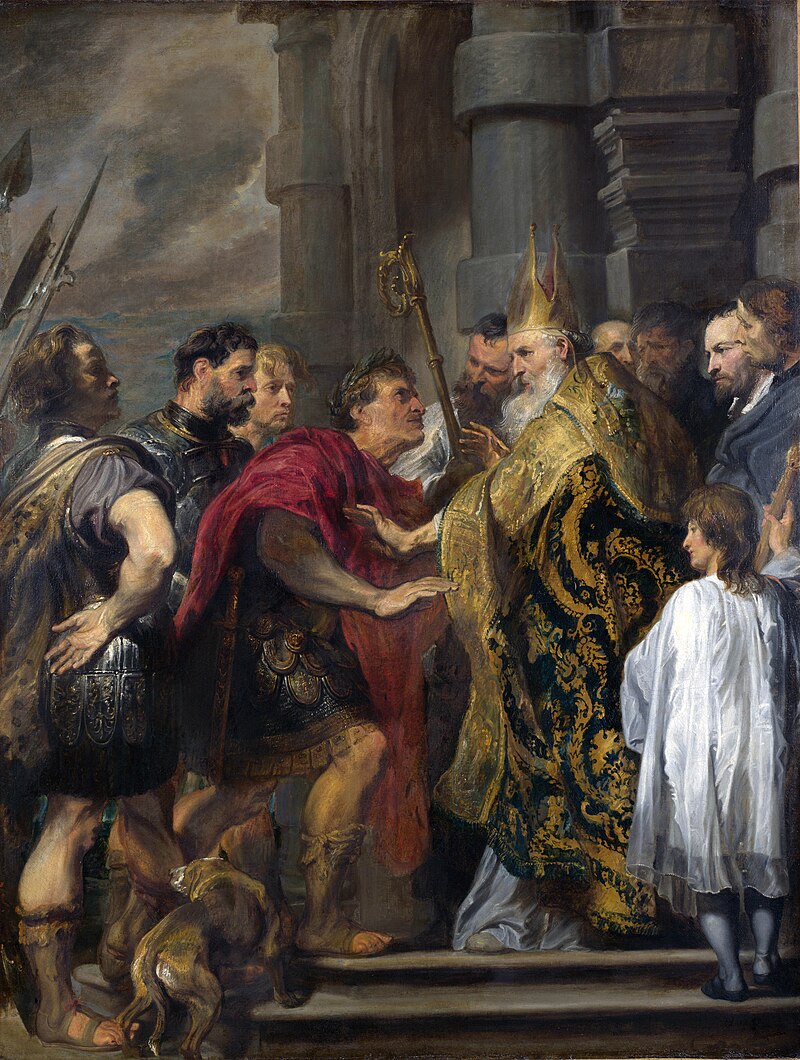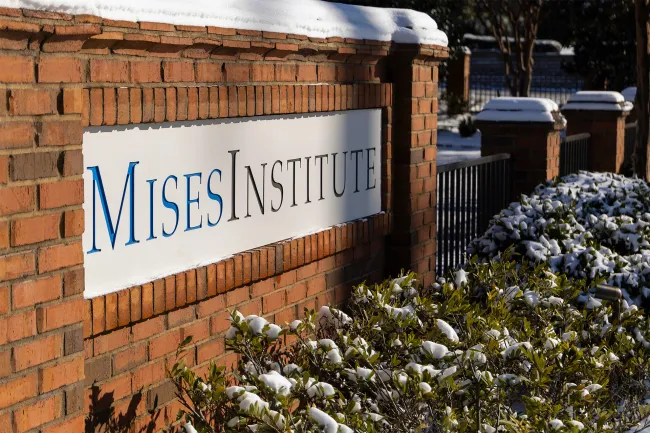[This article is a selection from Lecture 1 of Raico’s The Struggle for Liberty: A Libertarian History of Political Thought.]
The critical point was, again, the Middle Ages, and there you had an adversarial position between the church and the state that was, in fact, crucial. It goes back even before the Middle Ages, to the first centuries of the church.
This is represented, for example, in a painting by Flemish painter Van Dyke, which shows Saint Ambrose blocking the entrance to the Cathedral of Milan to the Emperor Theodosius. Ambrose did this because Theodosius had been involved in the massacre of many innocents in Thessalonica in the eastern Mediterranean, and Saint Ambrose considered this to be a sin that the emperor had not repented of. This 26 Ralph Raico was around the late fourth century. The scene of the painting is not the great Duomo of Milan that you see now. It was a forerunner cathedral, and Saint Ambrose, of course, was the archbishop of Milan and the man who converted Saint Augustine to Christianity.

The painting demonstrates in a very stark kind of way that the archbishop is standing there in front of the doorway and the emperor Theodosius had never experienced such a thing. You can see that he’s enraged, he’s totally frustrated: “What is this Church doing preventing me from entering a building of my empire?” But the emperor is not permitted to come into the building. Now, this is another example of the conflict between Ambrose and Theodosius. Theodosius demanded that Ambrose hand over the cathedral to the emperor, and Ambrose responded,
It is not lawful for us to deliver it up nor for Your Majesty to receive it. By no law can you violate the house of a private man and do you think that the house of God may be taken away? It is asserted that all things are lawful to the Emperor, that all things are his, but do not burden your con science with a thought that you have any right as Emperor over sacred things. It is written: God’s to God, Caesar’s to Caesar. The palace is the Emperor’s. The churches are the Bishop’s.1
That statement, by the way, comes from the New Testament: “Ren der unto Caesar what is Caesar’s and unto God what is God’s.” Lord Acton, earlier in his career, had identified that, in his view, as the origin of the idea of liberty; that is, there’s a realm that is not the state’s. Division now exists between what belongs to the state and what belongs to God, whereas ancient polities, the Greeks and the Romans—especially the later Roman Empire—did not make this distinction between what belonged to the state and what belonged to the gods. In the late Roman Empire, the emperors themselves were gods.
Now, as a matter of fact, Ambrose, was, as I mentioned, responsible for the conversion of Saint Augustine. With Saint Augustine we have an interesting development in his work on the city of God. This has been called the desacralization of the state. In the Roman Empire, Roma was a god with the particular sacrifices and religious obliga tions due to this god, representing the Roman state. Among the sac rifices—very stark kinds of sacrifices—were the ones that you would see in the Colosseum, sacrifices of Rome’s enemies in ways that are not even shown on Fox TV today. But what Augustine said was that this is Rome—“Rome Schmome”—and that this is the city of man. In contrast to the city of man, what is important is the city of God. As our eventual and permanent habitation, the city of God is infinitely more important than the city of man, thus desacralizing the state, which had been considered godlike by the Romans.
The Conflict Between Church and State
Now, much could be said about this adversarial position and hos tile interaction between the state and the Catholic Church in the Middle Ages. One important thing to keep in mind is that this did not hold for Christianity in general. In Byzantine Christianity, for instance, the state prevailed with what was called caesaropapism. That is the situation where the church was pretty much under the thumb of the emperor.
This was characteristic of Greek Christianity, and this is the kind of Christianity that the Russians inherited. So, under the Russian rulers and “tsars”—they took that title—they were effectively in charge of the church. It was a different kind of situation from Europe, and again we come across this idea of decentralization and division of power that was important because of the different small, decentralized polities.
Also important was the big division between the state and the church, whereas in other civilizations, the ruler himself was a god. We might point to the Roman emperor, or pharaoh, or the emperor of Japan—who was a direct descendant of the goddess of the sun—or the emperor of China. It was quite different in the West. And we can see this in a number of different ways and the role of the church.
These medieval limitations on the state are generally ignored today, and it is almost literally impossible for me to convince my students that the Middle Ages were not “the Dark Ages.” This Dark Ages myth is maybe the biggest—or one of the biggest, next to the myth of the Industrial Revolution—historical frauds perpetrated by Renaissance humanists and French philosophes.
One thing in particular I tell my students is that in the High Middle Ages, as Scholastic philosophy had been established, it was universally taught in every university—from Oxford to Salamanca to the Jagiellonian University of Krakow—that the prince was under the law. The ruler himself had to obey the law. Jacob Viner, the great economic historian and scholar at the University of Chicago, mentions, for instance, a reference to taxation by Saint Thomas Aquinas where Viner says Aquinas treats taxation as more or less an extraordinary act of a ruler which is as likely as not to be morally illicit.2 Viner points to a medieval papal bull, republished every year into the late eighteenth century, which threatened to excommunicate any ruler “who levied new taxes or increased old ones except for cases supported by law or in express permission from the Pope.”3 The popes were not into this adversar ial situation for their health. It was a question of one power against another power. It was good for us that there was countervailing power for the state in the West that did not exist in other civilizations. None the less, we find Thomas Aquinas himself talking about taxation as probably illicit.4 Similarly, this papal bull is saying that taxes would be illicit and not permitted except with papal control.
- 1
Ambrose to Marcellina, AD 385, in The Letters of S. Ambrose, Bishop of Milan (Oxford, 1881), pp. 133–34, https://www.tertullian.org/fathers/ambrose_ letters_02_letters11_20.htm#113. “At length came the command, ‘Deliver up the Basilica;’ I reply, ‘It is not lawful for us to deliver it up, nor for your Majesty to receive it. By no law can you violate the house of a private man, and do you think that the house of God may be taken away? It is asserted that all things are lawful to the Emperor, that all things are his. But do not burden your conscience with the thought that you have any right as Emperor over sacred things. Exalt not yourself, but if you would reign the longer, be subject to God. It is written, ‘God’s to God and Caesar’s to Caesar.’ The palace is the Emperor’s, the Churches are the Bishop’s. To you is committed jurisdiction over public not over sacred buildings.’ Again the Emperor is said to have is sued his command, ‘ I also ought to have one Basilica;’ I answered ‘It is not lawful for thee to have her. What hast thou to do with an adulteress who is not bound with Christ in lawful wedlock?’”
- 2
Viner, Religious Thought and Economic Society, ed. Jacques Melitz and Don ald Winch (Durham, NC: Duke University Press, 1978), p. 105.
- 3
From “In Coena Domini” (article 5), a recurrent papal bull between 1363 and 1770, first written by Urban V and modified by later popes until Pope Ur ban VIII: “All who shall establish in their lands new taxes, or shall take it upon them to increase those already exiting, except in cases provided for by the last in the event of obtaining the express permission of the Holy See.”
- 4
In a manner similar to Viner, theologian Ronald H. Preston concludes, “Aquinas treats taxation as an extraordinary act of a ruler and quite likely to be morally illicit; the presumption is that taxation is not a routine measure, and one legitimate only as a last resort.” Preston, Religion and the Ambiguities of Capitalism (Cleveland, OH: Pilgrim, 1993), p. 147.


